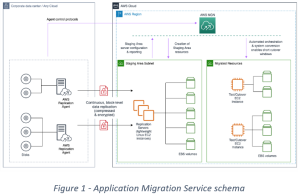Why use Application Migration Service when migrating to the Cloud?
AWS Application Migration Service is a tool that helps customers migrate their applications to the cloud by automating much of the migration process. This service is designed to make it easy for organizations to move their existing applications to the cloud without having to spend significant amounts of time or resources on manual migration tasks.
One of the key benefits of AWS Application Migration Service is that it supports a wide range of applications, including web applications, batch processing applications, and databases. This makes it a versatile tool that can be used for a variety of migration scenarios.
Some key features and benefits of AWS Application Migration Service:
- Automated Migration: AWS Application Migration Service automates many of the tasks involved in migrating applications to the cloud. This reduces the amount of time and resources required to complete the migration and minimizes the risk of errors or issues during the process.
- Compatibility: The service is compatible with a wide range of applications and operating systems, including Windows, Linux, and Unix. This allows organizations to migrate their applications regardless of the underlying technology stack.
- Scalability: AWS Application Migration Service is designed to handle large-scale migrations, making it suitable for organizations with large and complex application environments.
- Flexibility: The service supports a variety of migration strategies, including lift-and-shift, replatforming, and refactoring. This allows organizations to choose the approach that best suits their needs and objectives.
- Security: AWS Application Migration Service is built on AWS, which has robust security features and compliance certifications. This ensures that organizations can migrate their applications to the cloud with confidence, knowing that their data is secure.
Overall, AWS Application Migration Service is a powerful tool that can help organizations accelerate their journey to the cloud. By automating much of the migration process and supporting a wide range of applications, this service makes it easier and more cost-effective to migrate to AWS.
Deployment Overview
In order to use Application Migration Service, the first step is to create a template that will guide all configuration aspects of the migration, from the type of instance to use in the AWS environment, the network where is going to be allocated, the restrictions in bandwidth to use during the migration (if needed), etc. After that, the source servers are added by installing the AWS Replication Agent on each individual server. As the agents are installed the migration starts and can be monitored in the AWS console.

A representation of a general schema of the application and a representation of the different elements involved in the process can be seen above in Figure 1.
Before launching the migrated instances in a production environment, these instances are migrated to a Staging Area in order to perform tests and make sure the applications behave as expected. After all tests are performed and the applications are running as expected the final stage of this process is the Cutover phase where the on-premises server can be turned off and the instance in the AWS environment is put in production.
This migration process is very useful, especially in situations where a server might contain several services running and there’s a lack of documentation about said services or dependencies. These cases can be easily bypassed as Application Migration Service migrates the actual state of the server (operating system included).
After the migration is concluded, and as long as the server is running, all alterations made in the source server are replicated to the instance in the Staging Area in order to have the most updated version upon Cutover.
AWS Application Migration Service helps users manage their migration by grouping Source servers and Applications in Waves if there are dependencies among applications. These are logical groups, describing the migration plan over time.
It’s possible to:
- Monitor the wave’s migration status, progress, and associated applications
- Perform operations on the wave, such as editing, tagging, and archiving
- Perform bulk operations on the applications associated with the wave
Summary
AWS Application Migration Service (MGN) is a highly automated lift-and-shift (rehost) solution that simplifies, expedites, and reduces the cost of migrating applications to AWS. It allows companies to lift-and-shift a large number of physical, virtual, or cloud servers without compatibility issues, performance disruption, or long cutover windows. MGN replicates source servers into your AWS account. When you’re ready, it automatically converts and launches your servers on AWS so you can quickly benefit from the cost savings, productivity, resilience, and agility of the Cloud. Once your applications are running on AWS, you can leverage AWS services and capabilities to quickly and easily replatform or refactor those applications – which makes lift-and-shift a fast route to modernization.


Leave A Comment